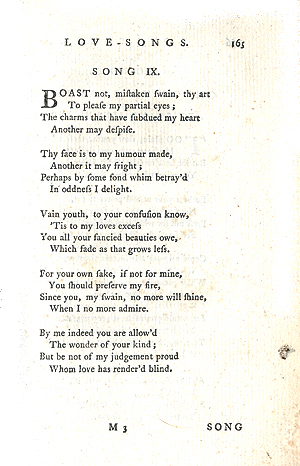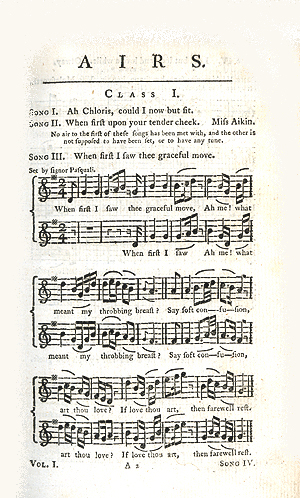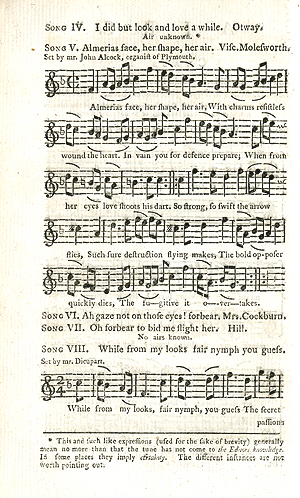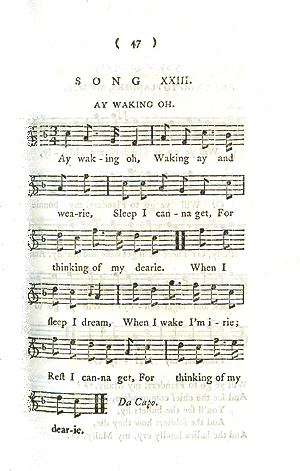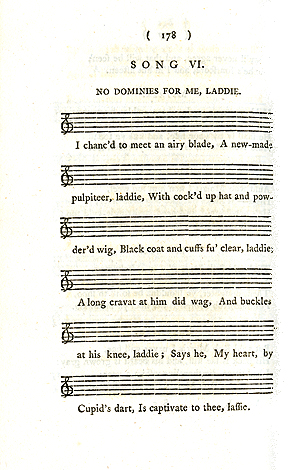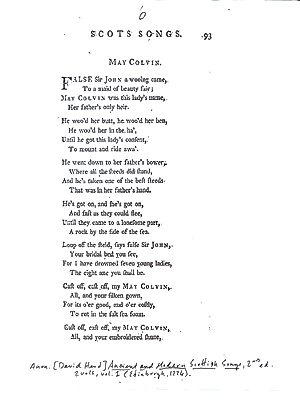Orality's Silence: The Other Ballad Revival
Janet Sorensen
Eighteenth-century technologies of the spoken and written word have come in for a good deal of attention in recent years, as writers have theorized the period’s complex models of mediations between orality, literacy, and print.[1] In elaborating the dense conceptualizations of the media systems through which songs and ballads then circulated, such studies have continued to interrogate the notion of a simple, immediate orality appropriated and transformed by the technologies of literacy and print—a notion whose origins are often associated with the eighteenth century, and particularly its ballad revival. Yet British writers of the eighteenth century themselves offered a wide range of quite different conceptualizations of the technologies of the spoken and written word and, what is more, imagined those technologies operating in distinct ways in different regional and national contexts, the key division often seen as being that between England and Scotland.
In this paper I shall examine the models evident in the writings of English antiquary Joseph Ritson, editor of two weighty collections of English and then Scottish songs and author of accompanying prefatory material detailing distinct understandings of the technologies of orality, literacy, and print in those respective spaces. His 1783 A Select Collection of English Songs in three volumes and his 1794 Scotish Songs [sic] in two volumes collect, codify, and contextualize national songs—implicitly oral artifacts, even when written first—offering key sites for looking at late eighteenth-century attempts to theorize the relationships between oral and literate media.[2] Ritson, in some ways the antiquaries’ antiquary, with his exacting, rigorous antiquarian methodologies and his voluminous treatises on the histories of national song—the reader must wade through near one hundred pages of his historical essay before getting to the English songs, for instance—brings to bear the full weight of antiquarian and polite literary print discourse on the spoken—and sung words—of Britain. His antiquarian rigor is evidenced in the fact that, although one of the first to be presented with fifteen ballad transcriptions of songs sung by Mrs. Brown of Falkland, Ritson rejected them, saying they are 'genuine but by no means ancient.'[3] He also confined himself to print sources, saying that among the many manuscripts he viewed, none had 'sufficient merit to mingle with the elegancies of the present collection' of English songs.[4]
Figure 1
And yet, as he brings the technologies of several print discourses to bear on song, Ritson draws a distinction between England and Scotland. It is my contention that in his print collections of Scots music, as well as those of Scots song collector David Herd, to whom I shall refer briefly, we find distinct imaginings of the technologies of the Scots spoken and written word—and more significantly their limits. Let me explain what I mean by distinct imaginings, first in Ritson’s presentation of English and Scots songs, respectively.
Figure 1 is a reproduction of the opening pages of the songs printed in Volume I of Ritson’s Select Collection of English Songs. The first two volumes of this collection printed the words alone of these songs, just as we see in this image. The only reminder that these might have been sung appears in the occasional prefatory remark 'song to the tune of ___,' where the blank is filled in with any number of well known popular tunes. Ritson prints what he calls the 'airs,' the musical notation to the songs, but only in a separate third volume, a represenative page of which appears in figure 2. Yet even in the pages of this separate volume of airs to English songs, quite a few songs receive the notice appearing near the top of figure 2, 'No air to the first of these songs has been met with, and the other is not supposed to have been set, or to have any tune.' An odd 'song' indeed, as Ritson had defined song as 'the expression of a sentiment, sensation or image, the description of an action, or the narrative of an event, by words differently measured, and attached to certain sounds, which we call melody or tune.'[5]
Figure 2
Figure 2 (detail)
Similarly, at the bottom of figure 3, Ritson casually notes, 'This and such like expressions generally mean no more than that the tune has not come to the editor’s knowledge. In some places they imply certainty. [That is, certainty that there is no tune.] The different instances are not worth pointing out.' So whether we know for certain that there is music—an air—or not to a 'song' is not very important. These are 'songs' in which the significance of a connection to an actual tune—and singing or hearing body—is negligible.
Figure 3
Figure 3 (detail)

In his Scotish Song, the case—and the presentation—is quite different. Here, in his opening paragraph, Ritson insists, 'the words and melody of a Scotish song should ever be inseparable' (i). And from the first song of the collection, located in the first volume, (figure 4), words and musical notation, 'melody' as he calls it, appear together, not in separate places, certainly not in separate volumes. Ritson explains the necessity of printing words and air together in terms of the period’s conventional associations of Scots music with sentiment and passion. Pastoral haven to a corrupted, commercial south, Scotland produces songs which, according to Ritson, 'when sung in the genuine natural manner, must affect the heart of every person of feeling, whose taste is not vitiated and seduced by fashion and novelty' (1). Scottish song, unlike English song, affects the heart, the body, in hearing. Their production is equally tied to feeling bodies. Ritson believes that the genuine and peculiar natural song of Scotland, is to be sought '?. . .in the productions of obscure or anonymous authors, of shepherds and milk maids, who actually felt the sensations they describe'? (lxxix). The essence of Scots song—simple, pastoral—unlike English song—artful, fashionable—is its connection to the body, available only through its singing and hearing. Scotland is, in these characterizations, essentially an oral space of voice, of sound—a space fulfilling a logocentrist’s vision of a community of embodied 'natural' presence, a vision Penny Fielding has discussed.[6]
Figure 4
We all know this version of Scotland and the north—vestigial space of a once-unified and wide-spread oral culture, its unusually impassioned and sentiment-eliciting song stands as the placemarker of that embodied oral world in a developing official print literary history. In these narratives of British literary history, Scots song is the location of the memory of an affective, if now ghostly, orality. Eighteenth-century English writers suspicious of these characterizations, most notoriously Samuel Johnson, had argued that those parts of Scotland bereft of written record, of literacy, such as the Highlands, far from marking some ethereal tie to a remote past were without a knowable history and therefore lacking in any connection to its past. That unknowable past was, in Johnson’s term, 'a vacuity,' and as Ian Duncan reminds us, Johnson was markedly hostile to those attempting to fill that vacuity, particularly those packing that empty space with 'Ossian'—accounts of third-century Scottish heroes and heroines for which James Macpherson falsely claimed to have discovered the manuscripts.[7] Johnson, alternatively, resolutely refused to fill the 'vacuity.'
Although Ritson indulges in the vision of Scots song’s proximity to the body and to an uncorrupted rural and oral world, his skepticism regarding the possibility of recovery of Scotland’s older songs resembles Johnson’s skepticism regarding the attempts to fill in its oral culture’s lost history. In some ways this is not at all surprising. Engaged in endless dispute with the Scot John Pinkerton, who had himself infamously forged sections of the ballad 'Hardyknute,' Ritson, in a rather Johnsonian quip, took to translating 'Timeo Daneaos'—loosely, 'I fear the Greeks, even when they bring gifts' as, instead, 'I dread a Scotchman bringing ancient verses.'[8] What might we make of Ritson’s skepticism, however, alongside his investment in the idea of the distinctively embodied nature of Scots songs, a belief shored up in his publication of Scotish Songs and his insistence on the printing of—only there and not in the English collection—words and melody together? This different form of presentation for Scots songs, as opposed to English songs, suggests a distinct sense of Scotland as, still, an inherently oral space, as historical remnant of embodied community. And yet at the same time, Ritson marks its unknowability. Oddly, in his volumes of Scotish Songs, Ritson prints a good number of songs that look like that represented in figure 5. When he could not find the 'proper air' for a song, he printed blank ledger-lines.[9]
Figure 5
On these strange pages, melody—even in its absence—and words remain inseparable. Ritson does not in the Scots songs, as he had in the collection of English songs, off-handedly remark that these might or might not have been set to music. His inclusion of blank ledger lines for every single Scots song for which he does not know the melody insists they were all at some point certainly set to music, the blank ledgers a visible reminder. In a sense Ritson here stages the vacuity of the oral. Not written down, unlike the words and sometimes melodies he has found in various print forms, the music to the Scots songs cannot be known authoritatively; they remain cyphers. And yet this absence must be marked in a way that it is not for the English songs.
Bertrand Bronson, in his critical biography Joseph Ritson, Scholar at Arms, notes that Ritson 'printed blank ledger lines for the owner of the volumes to fill in' (194), and Ritson himself writes, 'blank lines are left for its [a tune's] after insertion with the pen' (vi). But questions remain: Why are readers presented with blank ledger lines for the Scots songs and not the English? Why are readers given these print place markers for an insisted-upon melody, orality, body—absent yet starkly present in their marked absence—but only for Scottish songs? Why might readers be invited to fill in the blanks of Scots melodies but not of English ones? Why, to press it further, might readers be given the leeway to fill in the blanks of the ledger of Scots songs with their own personal knowledge when Ritson is otherwise at such pains to control the protocols of authenticity, antiquity, and politeness of the songs he prints?
I want to suggest that Ritson, in his collection of Scotish Songs, is influenced by a particularly Scots conceptualization of the relationship of the technologies of print and orality, particularly as they are seen to consolidate the social and the national. This conceptualization, or distinct imagining, as I called it above, undoes those characterizations of Scotland as either the space of a former—and ongoing reminder of—oral plenitude or of a place whose connection to the past is absolutely unknowable. And it does so via an appeal to the subjective in terms familiar from David Hume’s discussions of associationism. I want to try to demonstrate that by making a connection between Ritson’s work and that of David Herd, a Scots collector of Scots songs whom Ritson admired.
Like Ritson and many others, in his first 1769 edition Ancient and Modern Scottish Songs and in his later, two-volume 1776 edition Herd features a pastoral engraving on the title page, linking present-day Scotland to that past Golden age of song.[10] Yet in his preface Herd quickly moves away from claims of popular songs’ status as evidence, however ineluctably evanescent, of a far-off past, highlighting not preservation but disintegration. The printed word itself becomes a sign of that disintegration. Herd regrets that 'the poetry'—the printed words on the page—of the songs in his collection 'may appear much below mediocrity.'[11] He connects their 'below mediocrity' status to the fact that 'these were the only words existing to the tunes in question, the original words which gave rise to these tunes being irrecoverably lost' (ix). The original words are absent. What readers do have, in the form of words on the printed page of Herd’s collection, are proxies for those other, older, and superior vanished words. Operating within a signifying logic not entirely unlike Ritson’s blank ledgers, what the reader has in print is a reminder of what is missing and yet what is essential, even originary. It is those absent words, Herd insists, that 'gave rise to [the] tunes, which for Herd, like Ritson, are all important in Scots song (ix).
Figure 6
Herd’s songs appear, as in figure 6, as words alone. Herd does not include the tunes of the songs, not even giving such hints as 'sung to the tune of ...' Yet just as in some of Ritson’s Scotish Songs readers might fill in the blanks, Herd’s print presentation of songs assumes readers will bring to the words their own subjective memory of the 'airs.' He even writes, 'Of many of the songs in these volumes the chief merit will be found to consist in the musical air' (ix)—airs, which do not actually appear on the page but which are called up in the readers’ minds by 'the only words existing . . . the original words which gave rise to these tunes being irrecoverably lost' (ix). In both Ritson’s and Herd’s printing of Scottish songs, then, there is an unusual turn (at least for antiquarian discourse) to the subjective, to readers’ individual memories, and, related, as we shall see in a moment, to association to underwrite these mediations of oral and print technologies.
Consider, for instance, Herd’s description of the processes of association by which the sound of music in the individual reader’s present sets in motion terms of national affiliation more usually thought of as historically or even, in recent theorizations, print-driven. Invoking notions of association and habit explored by fellow Scot David Hume Herd writes:
That predilection so natural for every production of one’s own country, together with the force of habit, a certain enthusiasm attendant on music, and perhaps sometimes the principle of association, whereby other agreeable ideas are mingled and always called up to the mind together with the musical air, has ever induced people to prefer their own national music to that of all others (1776 vi).
In Herd’s language of associationism, contiguity of time and place of a national 'musical air' and of 'agreeable ideas' generates in the subjective mind a powerful sense of national connection and identification. Herd focuses on the moment of audition, on the instant a national subject hears a song, and the series of effortless mental connections that he believes quickly follow. In Herd’s description it is not the word but the 'air'—in a complex relation of oral media and aural reception—which set off the chain of associations that lead to national feeling. The tune or air, then, despite deriving from and occurring after the words, is the forceful catalyst of national feeling and remains intact, negotiating experience and continuity, even as the tune does not appear on the pages of Herd’s volumes.
I want to pause here for a moment to consider the complex operations of oral and print technologies called up by Herd’s and Ritson’s texts. Herd collects 'Ancient and Modern Scottish Songs' but admittedly prints in that collection words that are distant from and sad reminders of the missing original words. Those now-absent original words, he argues, were what gave rise to specific Scots tunes. Hearing any one of these tunes sets off a chain of subjective associations that nonetheless ultimately elicits feelings of national affiliation in all national subjects. Seeing words on the page presumably participates in that chain of associations, even initiating that chain of associations. Both Ritson’s blank ledgers and Herd’s words on the page point to what is absent, inviting subjective 'filling-in' of memory and association, an openness to subjective memory not countenanced in much antiquarianism of the late eighteenth century and not, seemingly, deployed in antiquarian projects in their presentations of English songs.
Both Ritson and Herd make gestures in the direction of a distinctly affective, embodied Scots song experience. Yet their printed works foreground the elusive and utterly mediated, yet also subjective qualities of that orality. In this they resemble no thinker so much as, again, Hume. Even in his most optimistic account of the possibility of retrieving the full presence of an historical event, when Hume argues that we might trace back representations of an historical event to 'an original impression', he introduces the intercession of signs. Commencing the entire chain of connections leading back to 'an impression of the memory or senses' are ?'characters and letters,' 'signs of certain ideas'—'delivery' both oral and written. What is more, these signs themselves operate on the principal of association. Hume writes,
because such a particular idea is commonly annexed to such a particular word, nothing is required but the hearing of that word to produce the correspondent idea ... it is not absolutely necessary, that upon hearing such a particular sound, we should reflect on any past experience .... The imagination of itself supplies the place of this reflection, and is so accustomed to pass from the word to the idea, that it interposes not a moment’s delay ....[12]
Hume’s implicit model of retrieval here is a post-Lockean linguistics of arbitrary customary association. While crediting the social with stable, reliable meaning-making, such a linguistic model also introduces the possibility of instability and multiplicity into knowledge, particularly historical knowledge. Indeed, few were better equipped to see the fault lines of a supposedly singular customary language in eighteenth-century Britain than educated Scots, who knew well that a single word might have a variety of meanings based on the distinct customs of different locations.
In Herd’s Hume-influenced volume, the presentation of un-annotated songs is especially conducive to their functioning as free-floating signs. Herd stands in stark contrast to an increasingly professionalized body of ballad collectors invested in authenticating those connections historically. Unlike most antiquarians, for instance, Herd offered little by way of authenticating commentary, even after Thomas Percy had pleaded with him to include such material. Instead, in refusing to specify an historical context [for?] the songs of his collection, Herd makes them available as signs that one might associate with 'agreeable ideas' and the nation—but on one’s own subjective terms of memory. Although Ritson, in contrast, goes to great lengths to provide extensive general historical context for both English and Scots songs in the armature of his extensive prefaces on the history of song, Ritson’s blank ledgers are, alternatively, open to subjective memory, suggesting in the reception of Scots song a process of association parallel to that described by Herd. Herd and Ritson, despite their immediately recognizable differences, both bring a complex understanding of the interplay of oral and print technologies to their collections of Scots music. Their printed texts represent distinct imaginings of those technologies in relation to Scotland and Scots music. Their 'silence' in regard to the actual tunes of some Scots music allowed for projections of the reader’s subjective imagination into the 'vacuity' as Johnson called it; projections with which Johnson might well not have been comfortable. Ritson’s blank ledgers both invite such projections but also announce and foreground an absence when it comes to a knowable, continuous oral production. Those blank spaces highlight that vacuity, noting that it stands in the very place that the presence and plenitude of oral communication was meant to occupy.
NOTES
[1] See for instance recent writing by Ian Duncan, Celeste Langlan, Susan Manning, and Maureen McLane.
[2] A Select Collection of English Songs 3 Vols. (London, 1783) and Scotish Songs, 2 Vols. (London, 1794).
[3] Letter cited in Bertrand Bronson, Joseph Ritson, Scholar-At-Arms 2 Vols., v. 1 (Berkeley: California UP, 1938), 192.
[4] Cited in Branson, v. 1, p. 82.
[5] A Select Collection of English Songs. vol. I p. i.
[6] “Writing at the North: Rhetoric and Dialect in Eighteenth-Century Scotland,” The Eighteenth-Century: Theory and Interpretation, 1998 (39), 25-43.
[7] “The Pathos of Abstraction: Adam Smith, Ossian, and Samuel Johnson” in Scotland and the Borders of Romanticism, eds. Leith Davis, Ian Duncan, and Janet Sorensen (Cambridge: Cambridge University Press, 2004), 38-56 (39).
[8] Cited in Bronson (190).
[9] Bronson, vol. 1,194.
[10] David Herd, The Ancient and Modern Scots Songs (Edinburgh, 1769) and Ancient and Modern Scottish Songs in Two Volumes (Edinburgh, 1776)
[11] Ancient and Modern Scottish Songs in Two Volumes (Edinburgh, 1776), v. I, ix.
[12] David Hume, A Treatise of Human Nature, Ed. L. A. Selby-Bigge, 2nd ed. P.H. Nidditch (Oxford: Oxford University Press), 93.

